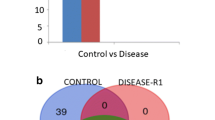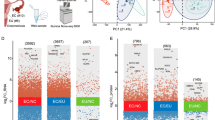Abstract
Uterine leiomyomas (fibroids) are the most common gynecological tumors, which are enriched in the extracellular matrix (ECM). Fibroids are leading cause of abnormal uterine bleeding and hysterectomy. One of the major questions yet to be answered is the overproduction of specific ECM components in human uterine fibroids, particularly in relation to mutations in the driver gene mediator complex subunit 12 (MED12). Surgical specimens from 14 patients with uterine leiomyoma having fibroids and corresponding adjacent normal myometrium (ANM) were utilized to analyze genetic and proteomic expression patterns in the tissue samples. MED12 mutations in the fibroids were screened by Sanger sequencing. iTRAQ was used to label the peptides in small-, medium-, and large-sized fibroid samples of annotated MED12 mutation from the same patient. The mixtures of the peptides were fractionated by hydrophilic interaction liquid chromatography (HILIC) and analyzed by liquid chromatography—tandem mass spectrometry (LC-MS/MS) to identify the differential expression proteins. Using isobaric tagged-based quantitative mass spectrometry on 3 selected patients, ECM-related protein tenascin-C (TNC) was observed significantly upregulated (>1.5-fold) with a confidence corresponding to false discovery rate (FDR) <1% in small-, medium-, and large-sized fibroid samples regardless of MED12 mutation status. The TNC was validated on additional patient samples using Western blotting (WB) and immunohistochemistry (IHC) and confirmed significant overexpression of this protein in fibroids compared to matched ANM. Proteomic analyses have identified the increased ECM protein expression, TNC, as a hallmark of uterine fibroids regardless of MED12 mutations. Further functional studies focusing on the upregulated ECM proteins in leiomyogenesis will lead to the identification of novel ECM drug targets for fibroid treatment.
Similar content being viewed by others
References
Cramer SF, Patel A. The frequency of uterine leiomyomas. Am J Clin Pathol. 1990;94(4):435–438.
Baird DD, Dunson DB, Hill MC, Cousins D, Schectman JM. High cumulative incidence of uterine leiomyoma in black and white women: ultrasound evidence. Am J Obstetr Gynecol. 2003;188(1):100–107.
Stewart EA, Laughlin-Tommaso SK, Catherino WH, Lalitkumar S, Gupta D, Vollenhoven B. Uterine fibroids. Nat Rev Dis Primers. 2016;2:16043.
Downes E, Sikirica V, Gilabert-Estelles J, et al. The burden of uterine fibroids in five European countries. Eur J Obstet Gynecol Reprod Biol. 2010;152(1):96–102.
Zimmermann A, Bernuit D, Gerlinger C, Schaefers M, Geppert K. Prevalence, symptoms and management of uterine fibroids: an international internet-based survey of 21,746 women. BMC Womens Health. 2012;12:6.
Coronado GD, Marshall LM, Schwartz SM. Complications in pregnancy, labor, and delivery with uterine leiomyomas: a population-based study. Obstet Gynecol. 2000;95(5):764–769.
Cardozo ER, Clark AD, Banks NK, Henne MB, Stegmann BJ, Segars JH. The estimated annual cost of uterine leiomyomata in the United States. Am J Obstetr Gynecol. 2012;206(3):211.e211–e219.
Sparic R, Mirkovic L, Malvasi A. Epidemiology of uterine myomas: a review. 2016;9(4):424–435.
Mehine M, Kaasinen E, Makinen N, et al. Characterization of uterine leiomyomas by whole-genome sequencing. N Engl J Med. 2013;369(1):43–53.
Mehine M, Kaasinen E, Heinonen HR, et al. Integrated data analysis reveals uterine leiomyoma subtypes with distinct driver pathways and biomarkers. Proc Natl Acad Sci. 2016;113(5):1315–1320.
Makinen N, Mehine M, Tolvanen J, et al. MED12, the mediator complex subunit 12 gene, is mutated at high frequency in uterine leiomyomas. Science. 2011;334(6053):252–255.
Clark AD, Oldenbroek M, Boyer TG. Mediator kinase module and human tumorigenesis. Crit Rev Biochem Mol Biol. 2015;50(5):393–426.
Taatjes DJ. The human Mediator complex: a versatile, genome-wide regulator of transcription. Trends Biochem Sci. 2010;35(6):315–322.
Jamaluddin MFB, Ko Y-A, Kumar M, et al. Proteomic profiling of human uterine fibroids reveals upregulation of the extracellular matrix protein periostin. Endocrinology. 2018;159(2):1106–1118.
Malik M, Norian J, McCarthy-Keith D, Britten J, Catherino WH. Why leiomyomas are called fibroids: the central role of extracellular matrix in symptomatic women. Semin Reprod Med. 2010;28(3):169–179.
Leppert PC. Comparative ultrastructure of collagen fibrils in uterine leiomyomas and normal myometrium. 2004;82(3):1182–1187.
Bulun SE. Uterine fibroids. N Engl J Med. 2013;369(14):1344–1355.
Leppert PC, Jayes FL, Segars JH. The extracellular matrix contributes to mechanotransduction in uterine fibroids. Obstet Gynecol Int. 2014;2014:783289.
Arici A, Sozen I. Transforming growth factor-beta3 is expressed at high levels in leiomyoma where it stimulates fibronectin expression and cell proliferation. Fertil Steril. 2000;73(5):1006–1011.
Arslan AA, Gold LI, Mittal K, et al. Gene expression studies provide clues to the pathogenesis of uterine leiomyoma: new evidence and a systematic review. Hum Reprod. 2005;20(4):852–863.
Leppert PC, Catherino WH, Segars JH. A new hypothesis about the origin of uterine fibroids based on gene expression profiling with microarrays. Am J Obstetr Gynecol. 2006;195(2):415–420.
Sozen I, Arici A. Interactions of cytokines, growth factors, and the extracellular matrix in the cellular biology of uterine leiomyomata. Fertil Steril. 2002;78(1):1–12.
Ko YA, Jamaluddin M, Adebayo M, et al. Extracellular matrix (ECM) activates beta-catenin signaling in uterine fibroids. Reproduction. 2018;155(1):61–71.
Ono M, Yin P, Navarro A, et al. Paracrine activation of WNT/beta-catenin pathway in uterine leiomyoma stem cells promotes tumor growth. Proc Natl Acad Sci USA. 2013;110(42):17053–17058.
Norian JM, Malik M, Parker CY, et al. Transforming growth factor beta3 regulates the versican variants in the extracellular matrix-rich uterine leiomyomas. Reprod Sci. 2009;16(12):1153–1164.
Borahay MA, Al-Hendy A, Kilic GS, Boehning D. Signaling pathways in leiomyoma: understanding pathobiology and implications for therapy. Mol Med. 2015;21:242–256.
Orend G. Potential oncogenic action of tenascin-C in tumorigenesis. Int J Biochem Cell Biol. 2005;37(5):1066–1083.
Midwood KS, Hussenet T, Langlois B, Orend G. Advances in tenascin-C biology. Cell Mol Life Sci. 2011;68(19):3175–3199.
Halder SK, Laknaur A, Miller J, Layman LC, Diamond M, Al-Hendy A. Novel MED12 gene somatic mutations in women from the Southern United States with symptomatic uterine fibroids. Mol Genet Genomics. 2015;290(2):505–511.
Bajwa P, Nielsen S, Lombard JM, et al. Overactive mTOR signaling leads to endometrial hyperplasia in aged women and mice. Oncotarget. 2017;8(5):7265–7275.
Benjamini Y, Hochberg Y. Controlling the false discovery rate: a practical and powerful approach to multiple testing. J R Stat Soc Series B Methodol. 1995;57(1):289–300.
Sandberg A, Branca RM, Lehtio J, Forshed J. Quantitative accuracy in mass spectrometry based proteomics of complex samples: the impact of labeling and precursor interference. J Proteomics. 2014;96:133–144.
Farquhar CM, Steiner CA. Hysterectomy rates in the United States 1990–1997. Obstetr Gynecol. 2002;99(2):229–234.
Malik M, Britten J, Segars J, Catherino WH. Leiomyoma cells in 3-dimensional cultures demonstrate an attenuated response to fasudil, a rho-kinase inhibitor, when compared to 2-dimensional cultures. Reprod Sci. 2014;21(9):1126–1138.
Brunengraber LN, Jayes FL, Leppert PC. Injectable clostridium histolyticum collagenase as a potential treatment for uterine fibroids. Reprod Sci. 2014;21(12):1452–1459.
Makinen N, Heinonen HR, Moore S, Tomlinson IP, van der Spuy ZM, Aaltonen LA. MED12 exon 2 mutations are common in uterine leiomyomas from South African patients. Oncotarget. 2011;2(12):966–969.
Orend G, Chiquet-Ehrismann R. Tenascin-C induced signaling in cancer. Cancer Lett. 2006;244(2):143–163.
Jones PL, Jones FS. Tenascin-C in development and disease: gene regulation and cell function. Matrix Biol. 2000;19(7):581–596.
Imanaka-Yoshida K, Hiroe M, Yoshida T. Interaction between cell and extracellular matrix in heart disease: multiple roles of tenascin-C in tissue remodeling. Histol Histopathol. 2004;19(2):517–525.
Imanaka-Yoshida K, Matsumoto K, Hara M, Sakakura T, Yoshida T. The dynamic expression of tenascin-C and tenascin-X during early heart development in the mouse. Differentiation. 2003;71(4–5):291–298.
Willems IE, Arends JW, Daemen MJ. Tenascin and fibronectin expression in healing human myocardial scars. J Pathol. 1996;179(3):321–325.
Huang W, Chiquet-Ehrismann R, Moyano JV, Garcia-Pardo A, Orend G. Interference of tenascin-C with syndecan-4 binding to fibronectin blocks cell adhesion and stimulates tumor cell proliferation. Cancer Res. 2001;61(23):8586–8594.
Martin D, Brown-Luedi M, Chiquet-Ehrismann R. Tenascin-C signaling through induction of 14-3-3 tau. J Cell Biol. 2003;160(2):171–175.
Herold-Mende C, Mueller MM, Bonsanto MM, Schmitt HP, Kunze S, Steiner HH. Clinical impact and functional aspects of tenascin-C expression during glioma progression. Int J Cancer. 2002;98(3):362–369.
De Wever O, Nguyen QD, Van Hoorde L, et al. Tenascin-C and SF/HGF produced by myofibroblasts in vitro provide convergent pro-invasive signals to human colon cancer cells through RhoA and Rac. Faseb J. 2004;18(9):1016–1018.
Huber MA, Kraut N, Beug H. Molecular requirements for epithelial-mesenchymal transition during tumor progression. Curr Opin Cell Biol. 2005;17(5):548–558.
Venning FA, Wullkopf L, Erler JT. Targeting ECM disrupts cancer progression. Front Oncol. 2015;5:224.
Grunert S, Jechlinger M, Beug H. Diverse cellular and molecular mechanisms contribute to epithelial plasticity and metastasis. Nat Rev Mol Cell Biol. 2003;4(8):657–665.
Oskarsson T, Acharyya S, Zhang XH, et al. Breast cancer cells produce tenascin C as a metastatic niche component to colonize the lungs. Nat Med. 2011;17(7):867–874.
Artavanis-Tsakonas S, Rand MD, Lake RJ. Notch signaling: cell fate control and signal integration in development. Science. 1999;284(5415):770–776.
Logan CY, Nusse R. The Wnt signaling pathway in development and disease. Annu Rev Cell Dev Biol. 2004;20:781–810.
Chiovaro F, Martina E, Bottos A, Scherberich A, Hynes NE, Chiquet-Ehrismann R. Transcriptional regulation of tenascin-W by TGF-beta signaling in the bone metastatic niche of breast cancer cells. Int J Cancer. 2015;137(8):1842–1854.
Author information
Authors and Affiliations
Corresponding author
Rights and permissions
About this article
Cite this article
Jamaluddin, M.F.B., Nagendra, P.B., Nahar, P. et al. Proteomic Analysis Identifies Tenascin-C Expression Is Upregulated in Uterine Fibroids. Reprod. Sci. 26, 476–486 (2019). https://doi.org/10.1177/1933719118773420
Published:
Issue Date:
DOI: https://doi.org/10.1177/1933719118773420




